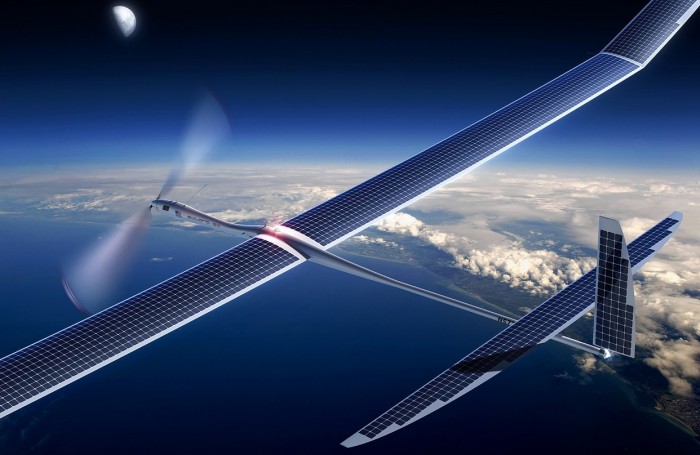Alphabet and Facebook’s Stratospheric Internet Plans Get Tangled in High-Altitude Red Tape
High above the annoyances of weather and commercial air traffic, the stratosphere could be a great place from which to beam down Internet connectivity to places with poor communications infrastructure. Alphabet and Facebook are both working on drones to operate 18 kilometers or more above Earth, and this year Alphabet will start using balloons at that altitude to serve mobile subscribers in Indonesia.
But even the stratosphere, which at the equator starts at around 20 kilometers but varies by latitude and season, is within reach of Earth’s regulators. To work at large scale, Alphabet and Facebook's schemes will need significant changes to national and international rules. “This is all somewhat uncharted territory,” says Yael Maguire, engineering director at Facebook’s connectivity lab, which is working on a drone called Aquila that has the wingspan of an airliner (see “Meet Facebook’s Stratospheric Internet Drone”). “There are ingredients required beyond the technology for this to work.”
Traditionally, the stratosphere’s traffic has been light, consisting of military aircraft, weather balloons, and space launches. Although each country’s national airspace extends to the edge of space, generally understood as 100 kilometers up, commercial regulators have mostly ignored the stratosphere, says Cassandra Steer, a researcher at the Center for Research on Air and Space Law at McGill University in Montreal.

The U.S. Federal Aviation Administration’s standard commercial aviation rules top out at 60,000 feet, just over 18 kilometers. “How regulators will treat commercial operations in the stratosphere is a little unclear,” says Steer.
Alphabet’s Project Titan drones, already in flight testing, and Facebook’s Aquila, set to start flying this year, will also need to follow laws for unmanned aircraft. But in many places, such as the U.S. and India, routine commercial drone flights are not allowed.
Regulations in place in the few countries that do permit commercial drone flights often include weight and altitude restrictions, and requirements that pilots can see their drones during flight. Those would exclude the Internet giants’ enormous craft.
Alphabet and Facebook also need the United Nations body that regulates communications satellites, the International Telecommunication Union (ITU), to get on board. It governs the radio channels used to transmit from different orbits, and it isn’t currently friendly to the idea of communications platforms in the stratosphere.
The two companies have teamed up and enlisted the help of the U.S. government to push the ITU to study how its rules could be changed (see “Facebook’s Internet Drone Team Is Collaborating with Google’s Stratospheric Balloons Project”). Maguire of Facebook cites that as evidence progress is being made on policy challenges. But when the ITU’s rules might actually change is unclear.
Alphabet’s Loon balloon effort is the most advanced of the airborne Internet projects and should face less regulatory turbulence. Balloons get special exceptions in national and international airspace rules because they cannot be steered like powered aircraft. In tests so far, the balloons have been flown millions of miles around the globe, and been used to serve mobile devices in countries including New Zealand, Chile, and Brazil.
However, Loon balloons’ range could be limited by diplomatic tensions because they must frequently cross national borders. Serving a single spot on Earth requires an endless procession of balloons overhead, as they constantly circumnavigate the globe with the stratosphere’s strong prevailing winds (see “10 Breakthrough Technologies 2015: Project Loon”).
Loon balloon tests started in the Southern Hemisphere in part in order to reduce the number of countries Alphabet needed to secure flyover permission from. The leader of the project said in 2014 that the company had permission from all the countries in the Southern Hemisphere, and Loon’s range has since extended—test flights recently started in Sri Lanka. But some countries may resist the idea of a U.S. corporation floating electronics-laden balloons into their airspace.
Denise Zheng, a senior fellow at the Center for International and Strategic Studies, says China is unlikely to look on Loon balloons favorably. “I don’t think China would let Google fly, and I wouldn’t be surprised to see them shoot a balloon down if it did stray over,” she says. A lack of coӧperation from China could make reliably serving nearby places such as Pakistan or northern India challenging. Loon balloons can be steered by changing their altitude to seek out winds going in slightly different directions, but can’t be piloted as reliably as conventional aircraft. Alphabet declined to say whether it had secured permission to fly balloons over China.
Alphabet and Facebook say they are working on their stratospheric crafts’ policy challenges, but also say they have strong interest from governments and established telecommunications companies, which could help smooth out regulatory wrinkles.
Maguire says Facebook has already heard from companies interested in operating Aquila drones when they are ready (Facebook doesn’t intend to operate the drones itself). Last month Sri Lanka’s government took a 25 percent stake in a joint venture aimed at rolling out Loon balloon coverage nationwide.
Keep Reading
Most Popular
Large language models can do jaw-dropping things. But nobody knows exactly why.
And that's a problem. Figuring it out is one of the biggest scientific puzzles of our time and a crucial step towards controlling more powerful future models.
The problem with plug-in hybrids? Their drivers.
Plug-in hybrids are often sold as a transition to EVs, but new data from Europe shows we’re still underestimating the emissions they produce.
How scientists traced a mysterious covid case back to six toilets
When wastewater surveillance turns into a hunt for a single infected individual, the ethics get tricky.
Google DeepMind’s new generative model makes Super Mario–like games from scratch
Genie learns how to control games by watching hours and hours of video. It could help train next-gen robots too.
Stay connected
Get the latest updates from
MIT Technology Review
Discover special offers, top stories, upcoming events, and more.